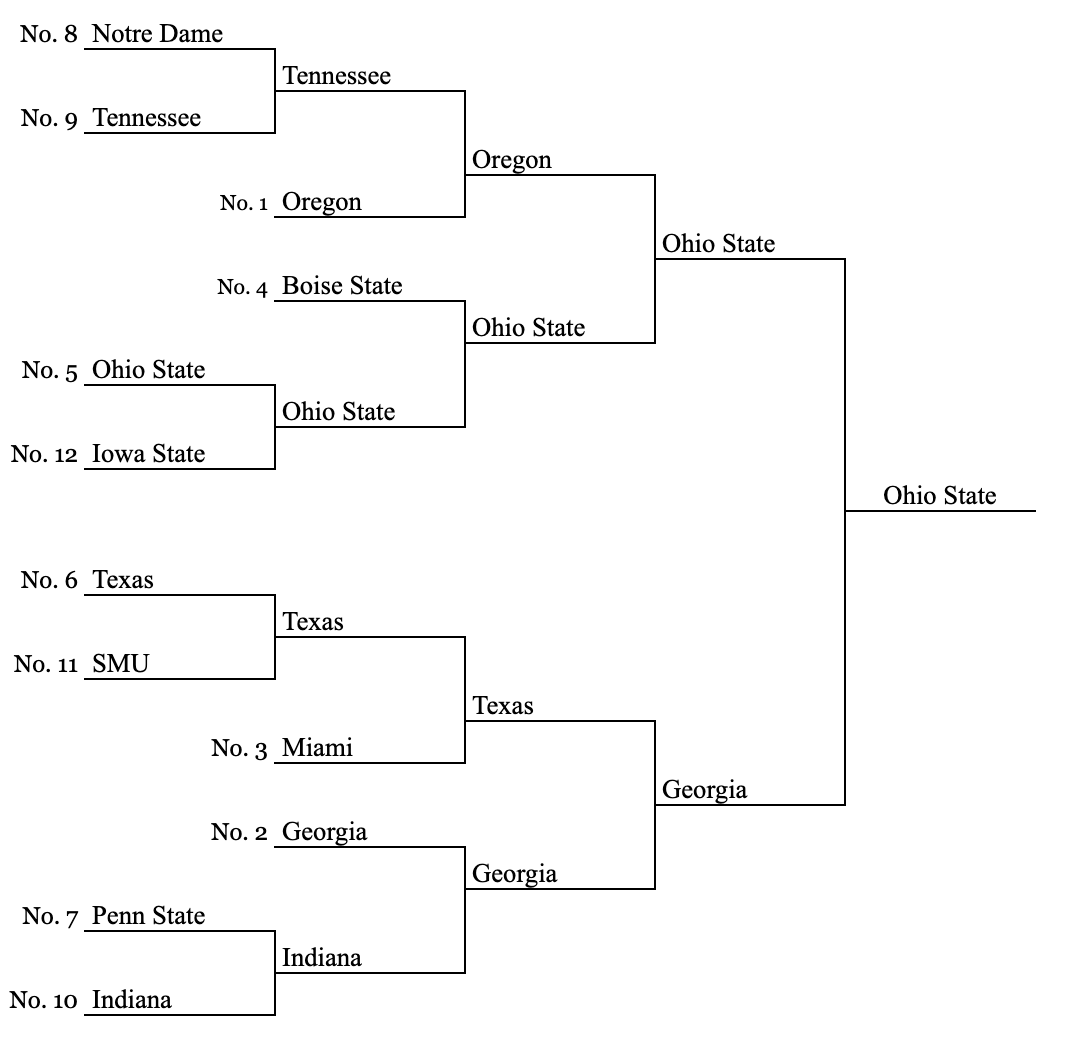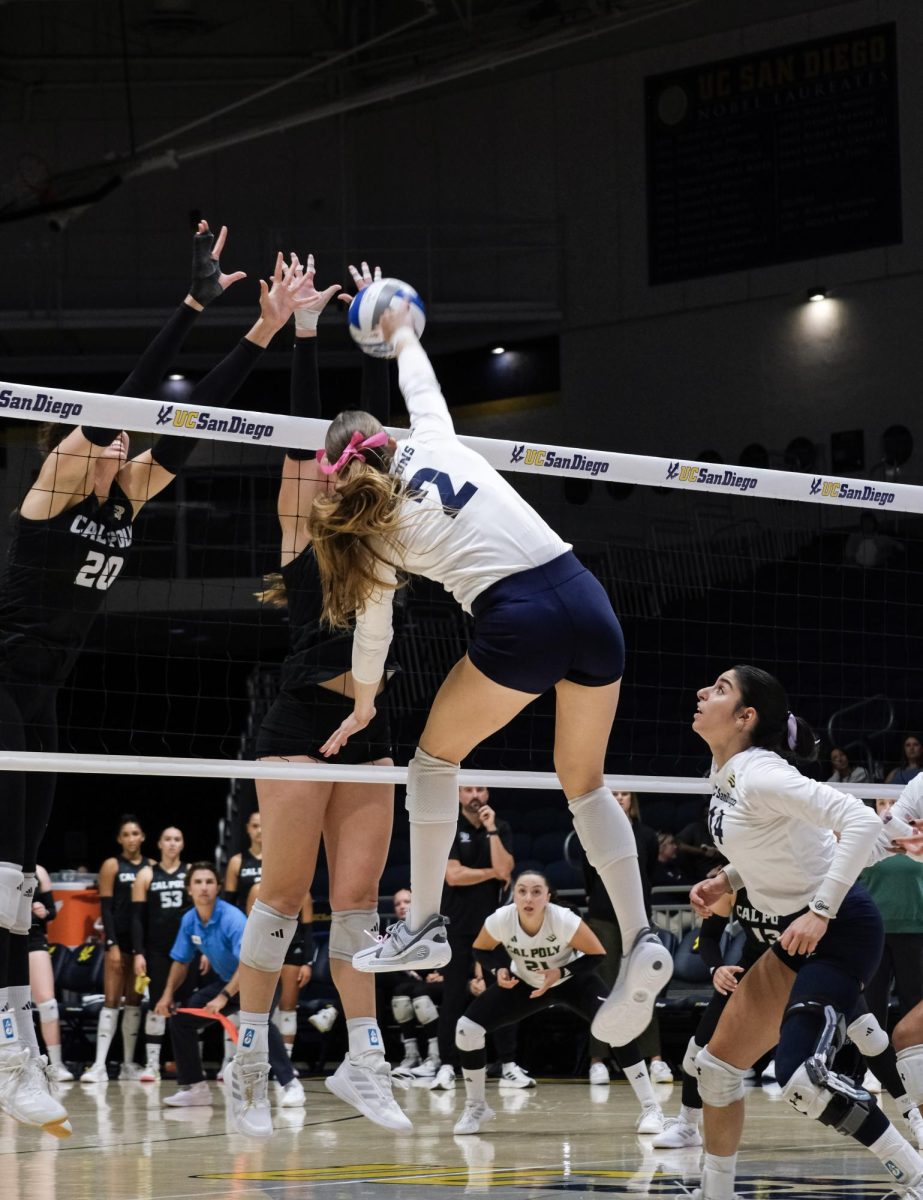The new College Football Playoff format only got one thing right: expanding from four teams to 12. Beyond that, the model is haphazard.
The CFP has always featured the top four teams in the country squaring off in two semifinals, followed by a National Championship game. This year, the landscape has been transformed dramatically: the field grows from four to 12 teams, the four highest-ranked conference champions earn a bye, and certain teams receive a home playoff game.
This overhaul follows last season’s Selection Day controversy, when undefeated Florida State (13-0) and defending national champion Georgia (12-1) were excluded from the playoffs entirely. With elite teams routinely excluded from the playoff, fans have implored the CFP committee for reform — and now, they have it.
Well, partially.
While the inception of the 12-team playoff stirs excitement, it also sows confusion. If you thought Selection Day Sunday would be less contentious this year, think again. The new format introduces several changes — many of which raise more questions than they resolve.
Let’s break down the new format:
The four highest-ranked conference champions earn byes
The four highest-ranked conference champions will receive the No. 1 to No. 4 seeds and earn first-round byes. According to The Associated Press’ Top 25 poll, these four teams would be Oregon, Texas, Miami, and Boise State, if the playoff began today.
This is fundamentally flawed and ill-conceived. Miami and Boise State are ranked No. 8 and No. 11 in the AP Top 25 poll; yet, with the new format, they would leapfrog higher-ranked teams. Meanwhile, Ohio State — the No. 2 team in the country — would fall to No. 5 and not earn a bye.
The fifth highest conference champion qualifies too, but with a twist
The fifth-highest-seeded conference champion also gets a ticket to the dance, but this, too, is controversial. If the fifth conference champion is ranked in the top 12, they retain that seed in the playoff. However, if they rank below the top 12, they automatically claim the No. 12 seed, displacing a more deserving team.
For example, if the playoff began today, the Big 12 champion would replace No. 12 Clemson. That Big 12 title game would feature No. 14 Arizona State and No. 17 Iowa State, with the winner earning the No. 12 seed, despite both teams being ranked outside of the top 12.
This system is absurd, and the only rational explanation is that the rule-makers smoked too much chicha when they promulgated the idea.
Pardon my French, but heavy chicha consumption impairs cognitive function. The fans wanted change, but this isn’t it. Instead, the committee should seed the teams No. 1 to No. 12, regardless of conference.
Teams in inferior conferences should have to dominate their conference to earn a spot in the playoffs. If not, their strength of schedule should stand out — especially compared to an SEC schedule. Otherwise, they should not make the playoff. A 10-2 Tennessee, who would likely be favored by at least a touchdown against BYU or Colorado, should not forfeit their spot to an inferior team.
Even more questions have surfaced about the new format:
- Why should the winner of the Big 12 championship — let’s say, a 9-2 Iowa State team — potentially earn the No. 4 seed and a bye, while a 10-1 Ohio State and a 10-1 Penn State fall to seeds No. 5 and No. 6?
- What about Notre Dame? They are a top 12 team but independent of a conference. Can we consider them a representative of an independent, fifth conference, thereby assuming one of the five conference seeds? If so, should Notre Dame earn a bye?
These are just two of the many questions the committee has either acknowledged but ignored or failed to consider entirely.
No. 5 to No. 8 seeds host home playoff games
Seeds No. 5 through No. 8 will host teams seeded No. 9 through No. 12 in first-round matchups for the first time in college football history. The remaining eight teams will be seeded based on the AP Top 25 poll, with the fifth conference champion seeded uniquely.
To resolve ties, the committee will consider head-to-head matchups, records against common opponents, and strength of schedule. The committee will announce its official rankings on Selection Day to reveal the finalized 12-team playoff bracket.
My comprehensive solution:
Step 1: Jettison the concept of a first-round bye for conference champions. Instead, rank the 12 best teams according to the AP Top 25 poll. A single, unified ranking would simplify the seeding process and reduce controversy. The current dynamic of two independent polls only adds confusion.
Step 2: Place more of an emphasis on win-loss records and strength of schedule. The current format incentivizes teams to schedule weak opponents. For instance, Indiana (10-1) held the No. 5 seed before Saturday’s loss to Ohio State despite not having played a team in the top 12. By contrast, No. 6 Georgia (9-2) was ranked No. 10 on Saturday, and the Bulldogs had played four teams in the top 12, including wins over No. 3 Texas and No. 7 Tennessee. If the Hoosiers and the Bulldogs played on a neutral field tomorrow, Georgia would be favored considerably. This exposes the rankings’ failure to reflect reality and, frankly, its hypocrisy.
Step 3: Abandon conference quotas. If the 12 best teams come from the SEC and Big Ten, so be it. The playoffs should represent the elite of college football — la crème de la crème — not a token mix of conference champions. A 10-1 Boise State team, which has not won a game against a top-25 opponent, should not be seeded higher than — let alone earn a bye over — a 9-2 Georgia team.
Ultimately, expanding the field will never satisfy the fans, no matter how far that expansion extends. Nick Saban made a brilliant point about this on the Pat McAfee Show on Friday afternoon:
“Look at the NCAA basketball tournament; they put 68 teams in and then they have a two-hour show on ESPN about who didn’t get in!” Saban continued. “It doesn’t matter whether it’s 12 teams [or] 16 teams; there’s always going to be a debate about who didn’t get in.”
Saban outlined how the old format consistently left out a team worthy of a playoff spot, where the first team out — the fifth best team in the country — often had a case for why they were better than the fourth team in the playoffs.
Saban explained, “There have been times in the past where … we [Alabama] won and lots of people thought Southern Cal should’ve got in. … The good news about [the new format] is they will get the best five or six teams in for sure.”
Here’s the bottom line: with a 12-team bracket, the best teams will make the playoffs.
2024-25 Predictions
First round:
- No. 5 Ohio State over No. 12 Iowa State (Big 12 champion; 5th highest-ranked conference champion)
- No. 6 Texas over No. 11 SMU
- No. 10 Indiana over No. 7 Penn State
- No. 9 Tennessee over No. 8 Notre Dame
Second round:
- No. 1 Oregon (Big Ten champion) over No. 9 Tennessee
- No. 2 Georgia (SEC champion) over No. 10 Indiana
- No. 6 Texas over No. 3 Miami (ACC champion)
- No. 5 Ohio State over No. 4 Boise State (Mountain West champion)
Semifinals:
- No. 5 Ohio State over No. 1 Oregon
- No. 2 Georgia over No. 6 Texas
CFP National Championship: No. 5 Ohio State over No. 2 Georgia
Ohio State: 31
Georgia: 21











Michael D Gordon • Nov 27, 2024 at 12:29 am
Not even close … Tenn over Oregon then Tenn over Ohio State…. Tex over Miami…Geo over Indiana. Geo over Tex …… Then Tennessee over Georgia ……..31 to 27
Wyatt Bose • Jan 20, 2025 at 8:30 pm
pretty close — actually, spot-on.
Don phillios • Nov 26, 2024 at 7:07 pm
Why should Georgia even be here?
ANDY AZ • Nov 26, 2024 at 3:45 pm
AZ State, not Corn State
Joey Haun • Nov 26, 2024 at 2:38 pm
If this is near correct then there will be two SEC teams in the championship game. Ohio State or Oregon is no match for either one of the SEC teams.
There should be 4 or 5 SEC teams in the top 12 teams.
Men play in the South Eastern Conference and the boys play in the other Conferences.
Jimmy Cooper • Nov 26, 2024 at 1:46 pm
The current format is absurd? Has the author ever heard of something called the NFL, where an 8 win division champion gets in the playoffs over a 12 win team that is not a division champion, and also gets a higher seed than that team in the playoffs? That is where the idea comes from, and it is also the format for the NBA, MLB, and other sports leagues as well. Teams get rewarded for winning their division/conference. That is fair.
You don’t exclude a division or conference champion because another team has a better record. If you don’t win your division or conference, then you have to have a better record than the other teams who also didn’t win theirs if you want a playoff spot.
And if a team is so far down the list that they don’t get the 12th spot because a conference champion with more losses gets in ahead of them, then that team didn’t earn their way into the playoffs.
You have to EARN your way into the playoffs. When their were only 4 teams, and conference champions, undefeated teams, and 1 loss teams were excluded, that was a problem. But when you have 12 teams, there should be no whining from multi-loss teams that don’t EARN a spot.
Thegigster • Nov 26, 2024 at 12:42 pm
Strength of schedule(SOS) should have greater weight than win loss so we don’t get a schedule full of easy wins.
The “1 plays 12” problem: Then you have six, or three, if you take this another round, and that doesn’t work. I like the 12 team with the 5-8 1st round and I think it emphasizes conf champ.
The balance is about whether we want a “pure ranking” final or highlight a conf.champion.
DuckLife • Nov 26, 2024 at 11:49 am
So Oregon beats Ohio State in the regular season and then again in the Big Ten championship game only to lose to them 3 weeks later in the semi-finals? Smoking a little too much Chicha there, Wyatt?
Wyatt Bose • Jan 20, 2025 at 8:39 pm
Ohio State (2024-25 National Champions) beat Oregon 41-21; just the right amount of chicha, actually.
Bigblue • Nov 26, 2024 at 10:42 am
This is a good article. Bottom line is that a 12 team (or more teams) should have been in place 25 years ago. Some tweaking can be done to current format, but it is good to have non power 4 teams in, gives them a reason to play. Best part of this system is that the winner will have to beat the best teams of all conferences and not hide behind their subpar conference schedule including some of the power 4 conference champios.
Jimdandy • Nov 26, 2024 at 10:08 am
Boise State actually defeated TWO ranked teams (UNLV and Washington State). Please check your facts.
Bob Wheeler • Nov 26, 2024 at 8:55 am
Why not break Div. 1 into 8 conferences with each conference having 2 divisions i.e. North/ South, East/West. Round 1 of the playoffs are the conference championships. That gets us to 8 remaining teams those teams would play in 4 Bowl’s on New Years day. The 4 winners would play 2 games a week later. The teams playing each other would be determined by a lottery draw. E.G. first team drawn would play second team drawn etc. Winners of those 2 games play each other 2 weeks later. This would give the two finalist a week of rest and rejuvenation and game planning. Much like the extra week between playoffs and Super Bowl.
Larry • Nov 26, 2024 at 6:36 am
Nice article. I agree with 99% of it. The only thing I think you were wrong about is Ohio State will be Big Ten Champions.
Karen • Nov 26, 2024 at 4:52 am
❤️ Ohio state all the was buckeyes